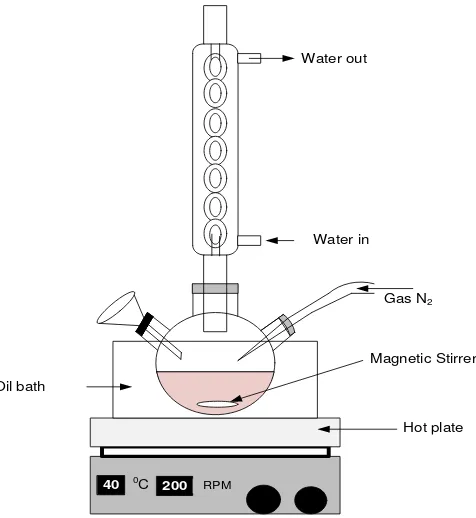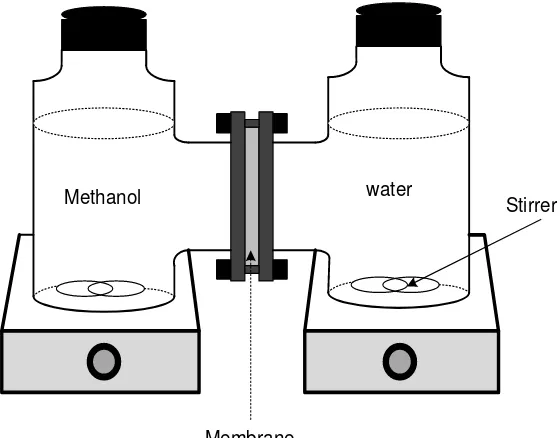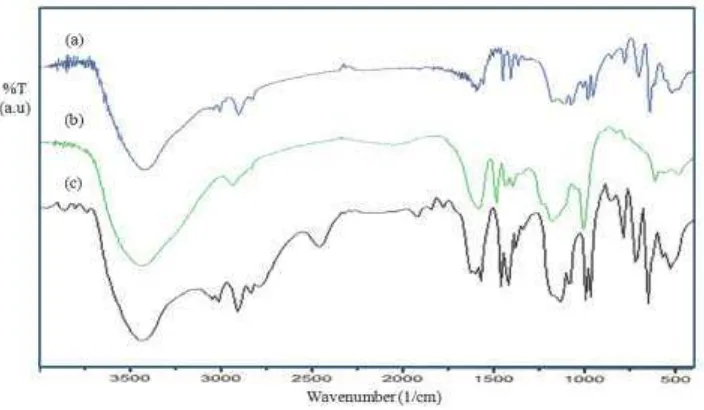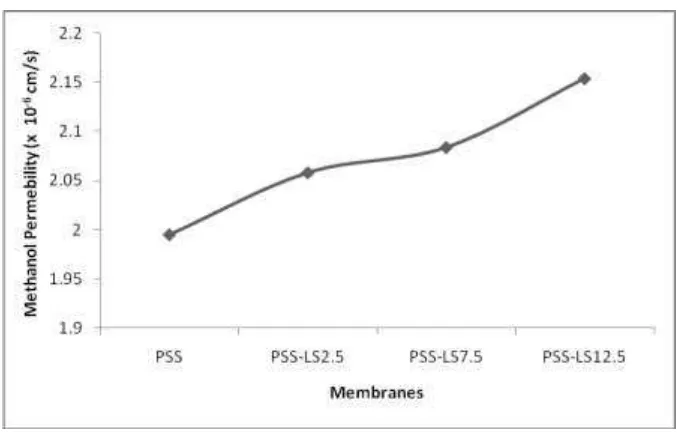Received October 20th, 2010, 1st Revision February 20th, 2012, 2nd Revision May 26th, 2012, 3rd Revision July 11th, 2012, Accepted for publication October 11th, 2012.
Copyright © 2012 Published by LPPM ITB, ISSN: 1978-3043, DOI: 10.5614/itbj.sci.2012.44.3.8
Properties of Polymer Electrolyte Membranes Prepared by
Blending Sulfonated Polystyrene with Lignosulfonate
Siang Tandi Gonggo1*, Cynthia L. Radiman2, Bunbun Bundjali2 & I Made Arcana2*
1Physical Chemistry Research Groups, Faculty of Teacher Training and Educational
Sciences, Tadulako University, Kampus Bumi Tadulako, Tondo, Jl. Sukarno Hatta Km 9 Tondo, Palu 94117, Indonesia,
E-mail: [email protected]
2Inorganic and Physical Chemistry Research Groups, Faculty of Mathematics and Natural Sciences, Institut Teknologi Bandung (ITB), Jalan Ganesha No. 10, Bandung
40132, Indonesia E-mail: [email protected]
Abstract. A polymer electrolyte membrane widely used in PEMFCs and DMFCs is a perfluorosulfonated membrane (the Nafion membrane). This perfluorosulfonated membrane material exhibits good chemical stability and proton conductivity, but it is very expensive and difficult to recycle. There is a high methanol crossover in DMFCs that causes a decrease in efficiency and performance of the fuel cell, so that a polymer electrolyte membrane with a low methanol crossover is needed as a substitute for the Nafion membrane. One of the materials that can be used as a polymer electrolyte membrane is the polyblends from sulfonated polystyrene-lignosulfonate (SPS-LS). Such polyblends were prepared by casting a polymer solution and characterized as polyelectrolyte membrane for DMFCs. The SPS was prepared by sulfonation of polystyrene with acetyl sulfate as the sulfonating agent. The membranes of the SPS-LS were characterized by analysis of functional groups, mechanical properties and methanol permeability. The maximum mechanical properties of the SPS-LS membrane were observed at an LS ratio of 7.5%. However, the methanol permeability of the membrane increased with the increase of the LS ratio in the SPS-LS membranes. The properties of the membranes, especially their mechanical properties and methanol permeability, were close to that of Nafion® 117 membrane, so SPS-LS membranes have high potential for use as polymer electrolyte membrane for direct methanol fuel cells.
Keywords: DMFC; lignosulfonate; polymer electrolyte membrane; polystyrene; sulfonated.
1
Introduction
of fossil fuels continuously causes the fossil-fuel reserves to diminish. The fossil fuel crisis has begun to be felt in society. According to S.M. Javaid Zaidi and Takeshi Matsuura [1], fossil-fuel production will peak in 2020 and thereafter decrease. In addition, continuous use of fossil fuels can cause serious environmental problems, such as global warming, climate change, melting of ice caps, acid rain, pollution, ozone layer depletion, forest and agricultural land damage, etc. [2]. Therefore, we need alternative energy sources that are environmentally friendly and renewable. One such environmentally and renewable energy source is the fuel cell.
One type of fuel cell with potential as an energy source is the direct methanol fuel cell (DMFC), which uses methanol directly as a fuel. The DMFC, like any other fuel cell, consists of an anode, a cathode and an electrolyte. The electrolyte of the DMFC is a solid polymer membrane. The DMFC is very interesting because it operates at low temperatures and because of its potential use in automotive, stationary, portable power applications, etc [3].The most important part of a DMFC is the polymer membrane as the electrolyte, which is sandwiched between the electrodes (anode and cathode) to form the membrane electrode assembly (MEA), because the performance of the fuel cell is largely determined by the ability of the membrane to transfer protons. The ideal electrolyte membrane for a DMFC has high proton conductivity, no conducting electrons, good mechanical strength, thermal stability and chemical stability, no methanol permeability, highwater uptake above 100C, and low production costs [1,4-6].
2
Materials and Methods
2.1
Materials
The materials used in this research,i.e. polystyrene (PS) (� � = 140.000 g/mol) and lignosulfonate acid (� �= 7.000 g/mol), were obtained commercially from Aldrich. Sulfuric acid (95-97%), acetic anhydride (Synth, p.a.), dichloromethane (DCM), 2-propanol, NaOH (Vetec), methanol, N,N-dimethyl formamide (DMF), toluene, and n-butanol were commercially obtained from Merck.
2.2
Methods
The sulfonation of the polystyrene (PS) was prepared by the following procedure [15,16]. First, acetyl sulfate was freshly prepared for use as the sulfonating reagent: 12 ml acetic anhydride was added to 24 ml dichloromethane (DCM) in a three-neck tube under a nitrogen atmosphere. The volume of the DCM was twice that of the acetic anhydride. The solution was cooled at about 0C, then 6 ml sulfuric acid (95-97%) in stoichiometric amount to the desired degree of sulfonation in the polymer was added into solution under a nitrogen atmosphere. The molar amount of acetic anhydride was added in slight excess to the sulfuric acid, so that the latter was completely converted to acetyl sulfate. Finally, the three-neck tube was capped, and the acetyl sulfate resulted in DCM solution was ready to be used. The equipment that was used in this synthesis is illustrated in Figure1.
21 g of atactic polystyrene (PS) was dissolved in 210 mL of DCM, which had previously been purged with nitrogen in a flask. The solution was maintained under nitrogen and then heated to 40C. The total amount of the prepared acetyl sulfate solution was added into the flask, and sulfonation was carried out for 80 minutes understirring. The reaction was stopped by adding 10 mL of 2-propanol and the resulting solution was cooled at room temperature. The sulfonated polymer was then precipitated in 1 L of distilled water at a temperature of about 80C. The polymer was filtered, washed for 2 h with distilled water at room temperature, and then filtered again. Finally, the sulfonated polymer was dried under vacuum at 60C for two days.
2.3
Preparation of Membranes
from the petri dish and soaked in distilled water for 3 h, before being tested. The membrane thickness was measured in the hydrated state by micrometer. For preparing the sulfonated polystyrene-lignosulfonate, the SPS was dissolved into a mixture of toluene/n-butanol (7/3 v/v), and the LS was dissolved in N,N-dimethyl formamide (DMF) with various concentrations. Both solutions were a mixture of toluene/n-butanol to DMF of 4/1 (v/v), and the solutions were stirred until homogeneous. The solutions were then cast onto a petri dish like the SPS membranes mentioned above, and finally the membranes were kept in distilled water.
Gas N2
40 0C 200 RPM
Water in Water out
Magnetic Stirrer
Hot plate Oil bath
Figure 1 Equipment used for the synthesis of SPS.
2.4
Analysis of Functional Groups
2.5
Analysis of Mechanical Properties
The mechanical strength of the membranes was measured by an Instron testing machine (Japan) with an operating head load of 50 N. The cross-sectional area of the samples was calculated. The membranes were then placed between the grips of the testing machine. The grip length was 4 cm, and the speed of testing was set at a rate of 50 mm/min [17]. The Young modulus was calculated according to Eq. (1) [16].
Young Modulus =Tensile Strenght
Strain (1)
2.6
Analysis of Methanol Permeability
Methanol permeability measurement was carried out using a diffusion cell. Initially, one compartment of the cell, B (VB = 100 mL), was filled with only
deionized water. The other compartment, A (VA = 100 mL), was filled with 5 M
methanol solution in deionized water. The membrane with a diffusion area of 1.77 cm2 was sandwiched by O-ring shaped Teflon and was clamped tightly between the two compartments, as illustrated in Figure 2.
Stirrer
Methanol water
Membrane
Figure 2 Illustration of the diffusion cell.
across the membrane was detected every time using Gas Chromatography (GC). The methanol concentration in compartment B was calculated according to Eq. (2):
effective area of the membrane, the thickness, and the volume of the permeated compartment, respectively. D, K, and (t-t0) are the methanol diffusion, the
partition coefficient between the membrane and the adjacent solution, and the time interval, respectively. The methanol permeability is defined as the product of diffusion and solubility (DK), and the concentration change of CB with time
is obtained from a linear slope, using Eq. (3).
Linear slope = dCB t
Methanol permeability = DK = dCB t
dt x were called SPS-LS2.5, SPS-LS5, SPS-LS7.5, SPS-LS10, and SPS-LS12.5, respectively. The polymer membranes were characterized extensively by analysis of functional groups (FTIR), mechanical properties (Tensile tester), and methanol permeability.
The FTIR spectra of the sulfonated polystyrene (SPS), the lignosulfonate (LS), and the SPS-LS are presented in Figure 3. The spectra of the SPS show absorption peaks at 1165-1180 and 1032 cm-1, indicating symmetric stretching vibrations of the aromatic –SO3H.The increased sharpness of the absorption
peak at 831 cm-1 shows the attachment of sulfonic acid groups at para position [18,19]. The peak identified at 1363 cm-1 is due to the asymmetric stretching of the S=O bond. The symmetric vibration of this bond produces the characteristic peak split of absorbance at 1150-1185 cm-1 [16, 18]. Additionally, the absorption peak at 3450 cm-1 is attributed to vibration of –OH from the
–SO3H group.
and 1700-1600 cm-1 indicates O-H stretching vibration, C=C group of a non-symmetric alkene in SPS and LS, and C=O stretching in LS molecular, respectively. They refer to the phenolic hydroxyl groups and carbonyl groups of the LS [20]. These FTIR absorption peaks reveal that the LS was incorporated into the SPS.
Figure 3 FTIR spectra of (a) SPS, (b) LS and (c) SPS-LS7.5.
One of the most important evaluations for a proton exchange membrane (PEM) is the analysis of its mechanical properties. In this work, the Young modulus of the SPS and the SPS-LS membranes were performed on an Instron tensile tester with a strain speed of 50 mm/min. Tensile strength and elongation at an elastic state of all membranes were evaluated at room temperature in fully hydrated states, of which the results are shown in Table 1. It can be seen that all membranes exhibited high Young modulus ranging from 414.41 to 610.25 MPa.
Table 1 Mechanical properties of the SPS-LS membranes.
Membrane Stress (MPa) Strain (%) Young Modulus (MPa)
SPS 11.84 2.31 512.09
SPS-LS2.5 14.43 2.54 567.87
SPS-LS5 14.62 2.42 604.80
SPS-LS7.5 15.84 2.61 610.25
SPS-LS10 11.41 2.63 434.75
SPS-LS12.5 11.74 2.83 414.41
improve the membrane’s mechanical strength. However, at a high weight ratio of LS, the Young modulus for the membranes decreases. The excessive LS can form a layer on the surface and disturb the membrane surface, especially through the formation of larger pores. This result was reported in a previous paper [21]. On the other hand, the elongation of the membrane increases with increasing LS content in the membranes.
Besides proton conductivity, the methanol permeability is one of the most important parameters for electrolyte membranes, particularly for the development of DMFC technology. The methanol permeability or methanol cross-over is a phenomenon of absorption of methanol as a fuel from the anode chamber through the membrane into the cathode chamber. Methanol cross-over in a DMFC can occur through diffusion and electro osmotic drag (EOD).
According to David P. Wilkinson, et al., 2010 [22], methanol cross-over is strongly influenced by the structure, morphology, thickness, acid group contents, temperature and concentration of the methanol used. Methanol permeability is reduced by using a thicker membrane material or using an equivalent weight of polymer membranes with a high. The ideal electrolyte membrane for a DMFC has no methanol cross-over, but it can transport water to the cathode to prevent drying of the cathode catalyst layer. Because of the similar properties of water and methanol it is difficult to separate methanol transport from water transport in the DMFC, which could be done to minimize methanol permeability. Analysis of methanol cross-over of the SPS-LS has been performed by a diffusion cell. Methanol cross-over analysis has been done on the SPS-LS-LS2.5, SPS-LS7.5, and SPS-LS12.5. The results of the calculation ranged from 2.06 x 10-6 to 2.15 x 10-6 cm/s. The methanol permeability profile is shown in Figure 4. The methanol cross-over of Nafion® 117 with the same treatment and measurement conditions is 2.08 x 10-6 cm/s.
Figure 4 shows that the methanol permeability increased as the LS ratio in the membranes increased. An increase of LS content in the SPS-LS membrane can increase the sulfonate (–SO3H) and carboxylic (–COOH) groups in the
Figure 4 Methanol permeability of SPS-LS membranes.
4
Conclusion
A new type of electrolyte membrane material for DMFCs has been prepared by blending SPS with LS through casting a polymer solution. The SPS-LS membranes show maximum tensile strength and Young modulus at an LS ratio of 7.5%. However, the presence of LS in the membranes can increase the methanol cross-over of the membranes. The properties of the membrane, especially the mechanical properties and methanol permeability, are close to those of the Nafion® 117 membrane, so this membrane is potentially useful for DMFC application.
Acknowledgements
The financial support for this research was provided by the General Directorate of Higher Education, Department of National Education, and the Ministry of Research and Technology, Republic Indonesia through competitive research grants. The authors gratefully acknowledge the support of the Institute for Research, LPPM, Institut Teknologi Bandung and Tadulako University.
References
[2] Vasquez, L.O., Fuel Cell Research Trends, New York, Nova Science Publishers, Inc., 2007.
[3] Zhao, T.S., Kreuer, K.D.& Nguyen, T.V., New York, Advances in Fuel Cell, Elsevier,2007.
[4] Sammes, N., Fuel Cell Technology, London, Springer Verlag, 2006. [5] Larminie, J. & Dioks, A., Fuel Cell Systems Explained, New York, John
Wiley & Sons. Ltd, 2003.
[6] Zhao, T.S., Micro Fuel Cells Principles and Applications, London, Academic Press, 2009.
[7] Chen, S.L., Bocarsly, A.B.& Benziger, J, 2005, Nafion-Layered
Sulfonated Polysulfone Fuel Cell Membranes, J. Power Sources, 152,
27-33.
[8] Dai, C.A., Liu, C.P., Lee, Y.H., Chang,C.J., Chao, C.Y.&Cheng, Y.Y., Fabrication of Novel Proton Exchange Membranes for DMFC via UV
Curing, J. Power Sources,177, pp. 262-272, 2008.
[9] Lee, C.H., Park, C.H.& Lee, Y.M., Sulfonated Polyimide Membranes Grafted with Sulfoalkylated Side Chains for Proton Exchange Membrane
Fuel Cell (PEMFC) Applications, J. Memb. Sci., 313, pp. 199-206, 2008.
[10] Chen, X., Yin, Y., Chen, P., Kita, H.& Okamoto, K.I., Synthesis and Properties of Novel Sulfonated Polyimides Derived from Naphthalenic
Dianhydridefor Fuel Cell Application, J. Memb. Sci., 313, pp. 106-119,
2008.
[11] Heo, K.B., Lee, H.J., Kim, H.J., Kim, B.S., Lee, S.Y., Cho, E., Oh, I.H., Hong, S.A.& Lim, T.H., Synthesis and Characterization of Cross-Linked
Poly(Ether Sulfone) for A Fuel Cell Membrane, J. Power Sources,
172,pp. 215-219, 2007.
[12] Tiitu, M., Torkkeli, M., Serimaa, R., Makela, T. & I kkala, O.T., Self-Assembly and Flow Alignment of Protonically Conducting Complexes of
Polystyrene-Block-Poly(4-Vinylpyridine) Diblock Copolymer with
Phosphoric Acid, Solid State Ionic, 176, pp. 1291-1299, 2005.
[13] Shin, J.P., Chang, B.J., Kim, J.H., Lee, S.B.&Suh, D.H, Sulfonated
Polystyrene/PTFE Composite Membranes, J. Memb. Sci., 251, pp.
247-254, 2005.
[14] Zhang, X., Benavente, J. & Valls, R.G., Porous Lignosulfonate
Membranes for Direct Methanol Fuel Cells, J. Memb. Sci., 276, pp.
301-307, 2006.
[15] Carretta, N., Tricoli, V. & Picchioni, F., Ionomeric Membranes Based on Partially Sulfonated Poly(Styrene): Synthesis, Proton Conduction and
Methanol Permeation, J. Memb. Sci., 166,pp. 189-197, 2000.
[16] Smitha, B., Sridhar, S. & Khan, A.A., Synthesis and Characterization of
Proton Conduction Polymer Membranes for Fuel Cell, J. Memb. Sci.,
[17] Zhu, X., Liang,Y., Pan, H., Jian, X. &Zhang, Y.,Synthesis and Properties
of Novel H-Bonded Composite Membranes from Sulfonated
Poly(Phthalazinone Ether)S for PEMFC, J. Memb. Sci., 312, pp. 59-65,
2008.
[18] Guan, R., Zou, H., Lu, D., Gong, C. &Liu, Y., Polyethersulfone Sulfonated by Chlorosulfonic Acid Andits Membrane Characteristics, European Polymer Journal, 41, pp. 1554-1560, 2005.
[19] Martins, C.R., Ruggeri,G. &Paoli, M.A.D, Synthesis in Pilot Plant Scale
and Physical Properties of Sulfonated Polystyrene,J. Braz. Chem. Soc.,
14, pp. 797-802, 2003.
[20] Zhang, X., Benavente, J. & Valls, R.G., Lignin-Based Membranes for
Electrolyte Transference, J. Powes Sources, 145, pp. 292-297, 2005.
[21] Gonggo, S.T., Arcana, I.M., Radiman, C.L. & Bundjali, B, Synthesis and
Characterization of Polyblends from Sulfonated
Polystyrene-Lignosulfonate as Ionomer Membranes, International Journal of
Materials Science (IJoMS), 6, pp. 1-14, 2011.
[22] Wilkinson, Zhang, D.P.J., Hui, R., Fergus, J. & Li, X., Proton Exchange
Membrane Fuel Cell Material Properties and Performance, New York,



